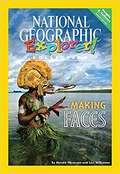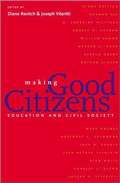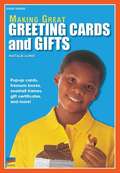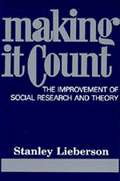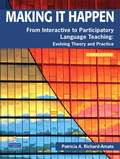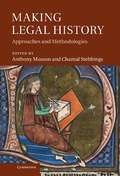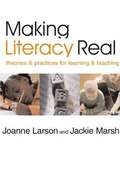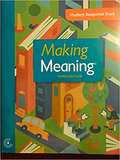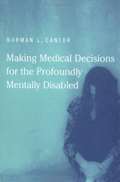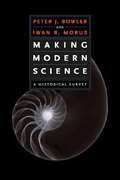- Table View
- List View
Making Faces, Pioneer Edition (National Geographic Explorer Collection)
by Ronald Naversen Lori WilkinsonNIMAC-sourced textbook
Making Good Citizens: Education and Civil Society
by Diane Ravitch Joseph P. ViterittiLeading thinkers from a variety of disciplines probe the relation between a healthy democracy and education. Contributors such as Jean Bethke Elshtain, Nathan Glazer, Robert Putnam, Jack Rakove, and Alan Wolfe discuss topics that range from the place of religion in public life to political conflict in a pluralist society to the problems of racial inequality.
Making Great Greeting Cards and Gifts
by Natalie Lunis Alison Adams Albert HannerFind out about how to make greeting cards and gifts using various materials.
Making It Count: The Improvement of Social Research and Theory
by Stanley LiebersonThere were many failures before humans successfully learned to fly. After watching birds flap their wings, bold and adventurous individuals built huge winglike structures, leaped off cliffs, flapped their wings vigorously, and broke their necks. There are principles of flight to be learned from watching the birds all right, but the wrong analogy had been drawn. In similar fashion, our empirical approach to social behavior is based on an analogy.
Making It Happen, from Interactive to Participatory: Language Teaching, Evolving Theory and Practice (4th Edition)
by Patricia A. Richard-AmatoNew to this edition: Separate chapters on implicit/explicit teaching and on a sociocultural/cognitive synthesis. New sections on focus form strategies, World Englishes, research directions, corpus analysis, dialogical assessment, and the Acoma heritage language program. The research has been updated throughout and reflects influential thinking for the 21st century. Part 1: Theoretical Considerations - Explores current theory and research; builds a case for emergent participatory teaching; and highlights literacy development, self-directed learning strategies, and current assessment issues and practices. Part II: Exploring Methods and Activities - Presents a practical reservoir from which teacher can draw as they develop their own methodologies and local practice. Part III: Putting It All Together: Some Practical Issues - Considers issues critical to program development, lesson design, textbook and computer program selection, video use; teacher research and professional development (including SOP). Part IV: Programs in Action - Describes K-Adult Programs (ESL, Foreign Language, Bilingual, and Tribal Heritage). Part V: Case Studies: Teacher Narrations to Stimulate Professional Dialogue - Presents case studies, ranging from kindergarten through university levels.
Making Legal History
by Chantal Stebbings Anthony MussonDrawing together leading legal historians from a range of jurisdictions and cultures, this collection of essays addresses the fundamental methodological underpinning of legal history research. Via a broad chronological span and a wide range of topics, the contributors explore the approaches, methods and sources that together form the basis of their research and shed light on the complexities of researching into the history of the law. By exploring the challenges posed by visual, unwritten and quasi-legal sources, the difficulties posed by traditional archival material and the novelty of exploring the development of legal culture and comparative perspectives, the book reveals the richness and dynamism of legal history research.
Making Lemonade (Fountas & Pinnell Classroom, Guided Reading)
by Isadora HargroveNIMAC-sourced textbook. Lemons, Lemons, Lemons. What can you do with lemons? You can make and sell lemonade!
Making Literacy Real
by Joanne Larson Jackie Marsh`Joanne Larson and Jackie Marsh's Literacy Learning is easily the most theoretically sophisticated and practically useful discussion of sociocultural and critical approaches to literacy learning that has appeared to date' - James Paul Gee, Tashia Morgridge Professor of Reading, University of Wisconsin-Madison Making Literacy Real is the essential reference text for primary education students at undergraduate and graduate level who want to understand literacy theory and successfully apply it in the classroom. Doctoral students will find this a useful resource in understanding the relationship of theory to practice. The authors explore the breadth of this complex and important field, orientating literacy as a social practice, grounded in social, cultural, historical and political contexts of use. They also present a detailed and accessible discussion of the theory and its application in the primary classroom. The book covers: o Defining literacy: multimodalities and new literacies o Digital literacies o New literacy studies o Critical literacy o Sociocultural-historical theory o Connecting theoretical frameworks o Implications for teacher education and literacy research Each chapter examines a theoretical model, accompanied by a discussion of case study material with a leading proponent of the field, including Barbara Comber, Michele Knobel, Colin Lankshear, Barbara Rogoff and Brian Street.
Making Meaning: Strategies That Build Comprehension and Community, Grade 7 Student Book, Volume 2
by Developmental Studies CenterNIMAC-sourced textbook
Making Meaning: Strategies That Build Comprehension and Community, Grade 4 Student Book
by Developmental Studies CenterLanguage Arts Textbook.
Making Meaning®, Grade 1, Reproducibles
by Center for the Collaborative ClassroomNIMAC-sourced textbook
Making Meaning®, Grade 2, Reproducibles
by Center for the Collaborative ClassroomNIMAC-sourced textbook
Making Meaning®, Grade 3, Reproducibles
by Center for the Collaborative ClassroomNIMAC-sourced textbook
Making Meaning®, Grade 5, Reproducibles
by Center for the Collaborative ClassroomNIMAC-sourced textbook
Making Meaning, [Grade 5] Student Response Book
by Developmental Studies CenterNIMAC-sourced textbook
Making Meaning®, Grade K, Reproducibles
by Center for the Collaborative ClassroomNIMAC-sourced textbook
Making Medical Decisions for the Profoundly Mentally Disabled
by Norman L. CantorNorman Cantor analyzes the legal and moral status of people with profound mental disabilities -- those with extreme cognitive impairments that prevent their exercise of medical self-determination. He proposes a legal and moral framework for surrogate medical decision making on their behalf. The issues Cantor explores will be of interest to professionals in law, medicine, psychology, philosophy, and ethics, as well as to parents, guardians, and health care providers who face perplexing issues in the context of surrogate medical decision making. The profoundly mentally disabled are thought by some moral philosophers to lack the minimum cognitive ability for personhood. Countering this position, Cantor advances both theoretical and practical arguments for according them full legal and moral status. He also argues that the concept of intrinsic human dignity should have an integral role in shaping the bounds of surrogate decision making. Thus, he claims, while profoundly mentally disabled persons are not entitled to make their own medical decisions, respect for intrinsic human dignity dictates their right to have a conscientious surrogate make medical decisions on their behalf. Cantor discusses the criteria that bind such surrogates. He asserts, contrary to popular wisdom, that the best interests of the disabled person are not always the determinative standard: the interests of family or others can sometimes be considered. Surrogates may even, consistent with the intrinsic human dignity standard, sometimes authorize tissue donation or participation in non-therapeutic medical research by profoundly disabled persons. Intrinsic human dignity limits the occasions for such decisions and dictates close attention to the preferences and feelings of the profoundly disabled persons themselves. Cantor also analyzes the underlying philosophical rationale that makes these decision-making criteria consistent with law and morals.
Making Modern Science: A Historical Survey
by Peter J. Bowler Iwan R. MorusA textbook about the history of modern science with cross-references. The book is divided into two parts, one on episodes, the other on themes. It covers all major developments in scientific thinking--evolutionism, genetics, nuclear physics, and modern cosmology.
